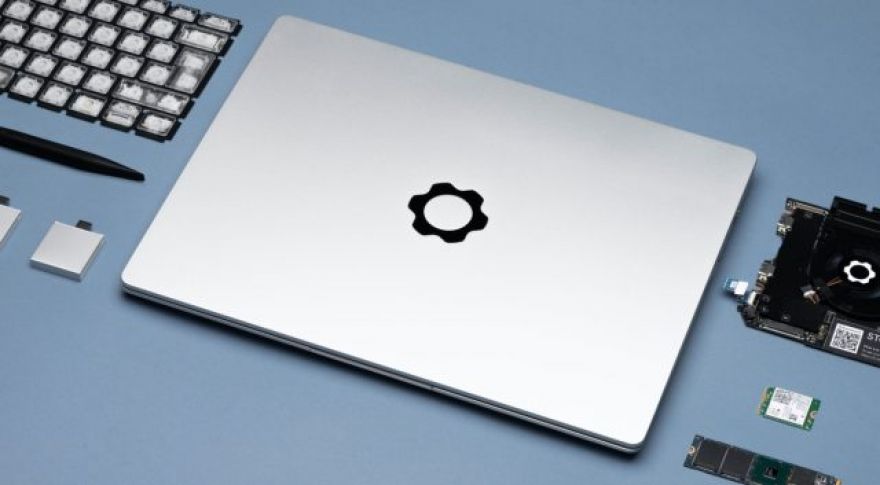
Framework Unveils Modular Laptop Coming This Summer 2021
User-expandable, customizable laptops have been a holy grail of computing for a long time, but they’ve remained more fiction than reality. Intel’s NUC laptop line offers some limited customization, but concepts like I/O flexibility have remained just that — concepts. A new startup named Framework argues it can change the entire playing field for mobile computing and launch an entirely new port ecosystem with its new Framework Laptop.
The is a 13.5-inch machine with a 3:2 2256×1504 resolution and a chassis weighing just 2.86 pounds. The webcam is supposedly a “fantastic” 1080p60 model and offers hardware privacy switches. The battery offers 55Whr and the system will support 11th Gen Core CPUs with support for WiFi 6E, 64GB of RAM, and 4TB or more of PCIe Gen 4 storage.
I’m dubious about the webcam claims, but only because laptop webcams are universally terrible. I’d love to be wrong on this. The rest of the system specs sound capable enough. Framework touts its commitment to upgradability, promising you’ll be able to swap the mainboard for other, faster variants in the future and that you’ll be able to order replacement components for all of its high-use hardware, including the battery, screen, keyboard, and bezels.
The Framework Laptop’s big claim to fame is the user-customizable I/O ports it offers. Framework promises that the machine will offer four I/O bays with launch support for USB-C, USB Type-A, HDMI, DisplayPort, microSD, and either a 250GB or a 1TB drive.
Internally, every module converts over to a USB-C interface. This is confirmed by an additional photo on the Framework website, where a tight zoom shows an internal USB-C connection on one side of the laptop, and by a photo from the blog post (below) showing the edge of the laptop motherboard with two metal connectors on the edge.
This is a clever concept. Framework wants to create an ecosystem of interchangeable hardware. Instead of paying for an HDMI-to-USB-C cable, you can just use the HDMI cable you’ve already got and pair it with the appropriate port. Want four simultaneous HDMI outputs? You can do that. Want four USB-A outputs? Extra storage? Bees? You can have all of them except the bees. You can, at least, have three of them — I’ll explain more below.
Framework makes it very clear that their long-term goal is to lower e-waste. The company’s rationale for its unique product, beyond the customization options it offers, is that it will also allow end-users to lower their device footprints by upgrading only when and what is needed. If you’ve ever had to throw away an entirely good laptop because one part failed, you can see the attraction.
Be advised, the Framework Laptop does not support an internal GPU. There has not yet been word on whether it will support an eGPU or not. Hypothetically it should be capable of doing so, but that depends on Framework.
The Framework Laptop Probably Won’t Be Inexpensive
Framework makes a lot of arguments in favor of customizability and reusability but says absolutely nothing about price points or cost. Do not expect this laptop to be inexpensive.
The first reason is that we’re being told semiconductor shortages could run the rest of the year. Nothing is cheap right now. Even allowing for this, however, the Framework Laptop is going to face some challenges. Launching a product ecosystem around a brand-new startup company is going to be one. The Framework Laptop won’t sell in tremendous volumes relative to what Dell or HP moves and makes it harder for the company to lock in low pricing. Moreover, the laptop is not a portstravaganza in and of itself. Ports have largely vanished off consumer systems, but you can still get them on enterprise and workstation models — Dell’s Precision 7750 workstation offers an SD card slot, three USB Type-A ports, mini-DisplayPort, HDMI, RJ-45, and dual Thunderbolt / USB-C ports. If what you need is ports, you can beat the Framework easily. This system is designed specifically for people who need four customizable ports and low weight as opposed to every single port standard still in use simultaneously.
Also, while Framework is advertising the fact that the system has four customizable ports, it’s not clear if the system includes a separate barrel plug for power. I’m inclined to think it doesn’t; a lot of laptops have switched to USB-C for this and there’s no mention of one. It also works against Framework’s stated goal of maximally reducing e-waste. If I’m right, the Framework Laptop more realistically offers a 1+3 port arrangement, with the option to use all four ports simultaneously so long as the battery holds out. If you specifically need all four ports to be available at all times in addition to charging, this may not be the laptop for you. ET has confirmed with Framework Laptop that this is the case.
I want to like the Framework, but the company is facing tough odds. Efforts to bring modular products to market like Moto Mods or Google’s Project Ara variously limp along or fail (respectively). Sometimes, the companies backing them just quit. Regardless of the reason, few are successful.
It’s hard to imagine this system coming to market without carrying a substantial premium over more conventional laptop designs. It’s even harder to imagine its Expansion Card system won’t be pricy compared with just plugging a cable into a regular laptop’s USB-C port. There’s nothing wrong with building a laptop explicitly intended to minimize long-term e-waste, but the Framework’s long-term success will depend on how successfully the system pushes past this metric and into the realm of “Objectively great machine.”
Now Read:
- L